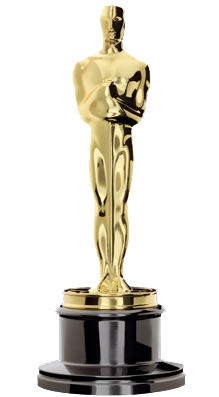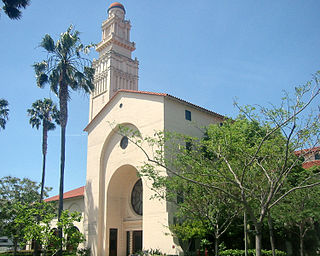
The Academy Awards, also known as the Oscars, are awards for artistic and technical merit for the film industry. They are presented annually by the Academy of Motion Picture Arts and Sciences (AMPAS), in recognition of excellence in cinematic achievements as assessed by the Academy's voting membership. The Academy Awards are regarded by many as the most prestigious, significant awards in the entertainment industry in the United States and worldwide. The Oscar statuette depicts a knight rendered in the Art Deco style.

Gladys Marie Smith, known professionally as Mary Pickford, was a Canadian-born American actress, producer, screenwriter and film studio founder, who was a pioneer in the US film industry with a Hollywood career that spanned five decades.

The Academy of Motion Picture Arts and Sciences is a professional honorary organization with the stated goal of advancing the arts and sciences of motion pictures. The Academy's corporate management and general policies are overseen by a board of governors, which includes representatives from each of the craft branches.
The Academy Award for Best Makeup and Hairstyling is the Academy Award given to the best achievement in makeup and hairstyling for film. Traditionally, three films have been nominated each year with exceptions in the early 1980s and 2002 when there were only two nominees; in 1999, when there were four nominees. Beginning with the 92nd Academy Awards, five films were nominated.
The University of Southern California School of Cinematic Arts (SCA) houses seven academic divisions: Film & Television Production; Cinema & Media Studies; John C. Hench Division of Animation + Digital Arts; John Wells Division of Writing for Screen & Television; Interactive Media & Games; Media Arts + Practice; Peter Stark Producing Program.
Margaret Florence Herrick, also known professionally as Margaret Gledhill, was an American librarian and the Executive Director of the Academy of Motion Picture Arts and Sciences. In 1971, the Academy's library was named the Margaret Herrick Library in her honor.

The 1st Academy Awards ceremony, presented by the Academy of Motion Picture Arts and Sciences (AMPAS) and hosted by AMPAS president Douglas Fairbanks, honored the best films from 1 August 1927 to 31 July 1928 and took place on May 16, 1929, at a private dinner held at the Hollywood Roosevelt Hotel in Los Angeles, California. Tickets cost $5 ; 270 people attended the event, which lasted 15 minutes. It is the only Academy Awards ceremony not broadcast on either radio or television; a radio broadcast was introduced for the 2nd Academy Awards.
The Academy Film Archive is part of the Academy Foundation, established in 1944 with the purpose of organizing and overseeing the Academy of Motion Picture Arts and Sciences’ educational and cultural activities, including the preservation of motion picture history. Although the current incarnation of the Academy Film Archive began in 1991, the Academy of Motion Picture Arts and Sciences acquired its first film in 1929.
Linwood G. Dunn, A.S.C. was an American pioneer of visual special effects in motion pictures and an inventor of related technology. Dunn worked on many films and television series, including the original 1933 King Kong (1933), Citizen Kane (1941), and Star Trek (1966–69).
The 21st Academy Awards were held on March 24, 1949, honoring the films of 1948. The ceremony was moved from the Shrine Auditorium to the Academy's own theater, primarily because the major Hollywood studios had withdrawn their financial support in order to address rumors that they had been trying to influence voters. This year marked the first time a non-Hollywood production won Best Picture, and the first time an individual (Olivier) directed himself in an Oscar-winning performance.

The Academy Museum of Motion Pictures is a museum in Los Angeles, California constructed by the Academy of Motion Picture Arts and Sciences (AMPAS), which is devoted to the history, science, and cultural impact of the film industry. It is the first large-scale museum of its kind in the United States. The museum is located in the historic May Company Building on the intersection Wilshire Boulevard and Fairfax Avenue, part of Museum Row on the Miracle Mile.

The 85th Academy Awards ceremony, presented by the Academy of Motion Picture Arts and Sciences (AMPAS), honored the best films of 2012 and took place on February 24, 2013, at the Dolby Theatre in Hollywood, Los Angeles beginning at 5:30 p.m. PST / 8:30 p.m. EST. The ceremony was the first in the Academy's 85-year history to adopt the phrase "The Oscars" as the ceremony's official name during the broadcast and marketing. During the ceremony, the Academy of Motion Picture Arts and Sciences presented Academy Awards in 24 categories. The ceremony was televised in the United States by ABC, and produced by Craig Zadan and Neil Meron and directed by Don Mischer. Actor Seth MacFarlane hosted the show for the first time.
The Governors Awards presentation is an annual award ceremony hosted by the Academy of Motion Picture Arts and Sciences (AMPAS), at the Grand Ballroom of the Hollywood and Highland Center, in the Hollywood district of Los Angeles, California. Three awards that signify lifetime achievement within the film industry – the Academy Honorary Award, the Jean Hersholt Humanitarian Award, and the Irving G. Thalberg Memorial Award – are presented at this ceremony. The first Governors Awards ceremony was held on November 14, 2009. Prior to this, these three awards were formally presented during the main Academy Awards ceremony, which now conducts a short mention and appearance of the awards recipients after displaying a montage of the Governors Awards presentation. In the years since, the awards have gained prominence as a major red-carpet destination and industry event.

Douglas Elton Fairbanks Sr. was an American actor and filmmaker. He was best known for his swashbuckling roles in silent films, including The Thief of Bagdad, Robin Hood, and The Mark of Zorro, but spent the early part of his career making comedies.

The Margaret Herrick Library, located in Beverly Hills, California, is the main repository of print, graphic and research materials of the Academy of Motion Picture Arts and Sciences (AMPAS). The library contains a digital repository and has historical materials that include those relating to the Oscars awards show.
Dawn Hudson is an American film industry executive.
The Don Lee Network, sometimes called the Don Lee Broadcasting System was an American regional network of radio stations in the old-time radio era.









